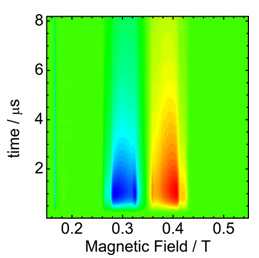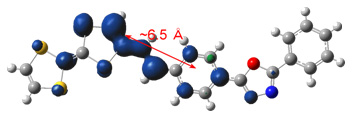
The collaborative research group of Dr. K. Furukawa, Prof. T. Nakamura from IMS, and Mr. Y. Sugishima and Prof. H. Fujiwara from Osaka Prefecture Univ. attempted to clarify the photoconductive mechanism of organic photoconductive materials from the viewpoint of electron spin. They suggest that the electron spin resonance (ESR) spectrum of a solution sample could be attributed to the photoexcited triplet state. They observed the preliminary ESR spectrum associated with the photoconductivity of a powder sample and concluded that the photoconductivity is assisted by a condensation effect arising in the solid.
The spin dynamics of photoconductive tetrathiafulvalene (TTF) derivatives containing 2,5-diphenyl-1,3,4-oxadiazole (PPD), either connected directly or via an alkene linker, were examined using time-resolved electron spin resonance (TR-ESR) spectroscopy.
Figure 1 shows the observed ESR spectrum for the TTF derivatives containing a PPD group. TR-ESR signals of a frozen solution sample under visible excitation were attributed to the excited triplet state T1, which was populated via intersystem crossing from the excited singlet state S0 as confirmed by TR-ESR spectral simulations. The zero-field splitting parameter |D|-value is estimated as ~0.07 m−1, which corresponds to the mean spin–spin distance of ~6.5 Å under the point–dipole approximation. From DFT calculations, the spin-density distribution of the T1 state (Figure 2) was found to be concentrated around the linker between the TTF and PPD molecules. This result was consistent with the spin–spin distance estimated from the |D|-value. Along with differences in the spin-density distribution, the different linking of the two molecules is reflected by a slight difference in the zero-field splitting parameter |D|. The charge separation state CS, which induces photoconductivity, could not be observed as an isolated system. Therefore, the intramolecular charge transfer might be assisted by a condensation effect arising in the solid. To clarify this, we obtained the preliminary TR-ESR spectra with a small D value for a powder sample under UV excitation. Detailed investigations on this sample are currently underway.

Figure 1. Two-dimensional time-resolved ESR spectrum of TTF derivatives containing a PPD group. The normal axis represents the ESR signal intensity. The color scale denotes the signal intensity. Positive and negative values indicate the absorption and emission of microwaves, respectively.

Figure 2. Spin-density distribution of TTF derivatives containing a PPD group estimated by DFT calculation.
Paper Information
Journal: Chemistry Letters, 40, 292-294 (2011).
Title: Photoinduced Triplet States of Photoconductive TTF Derivatives Including a Fluorescent Group
Authors: K. Furukawa, Y. Sugishima, H. Fujiwara, T. Nakamura
Related Information
http://www.ims.ac.jp/english/know_en/materials/nakamura/nakamura_en.html


